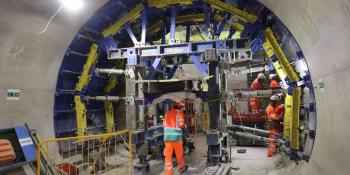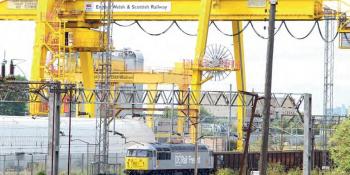BIGGEST-EVER COMMISSIONING VINDICATES NEW NR PROCESSES
THE BIGGEST signalling commissioning ever undertaken by Network Rail in one phase ended on 3 January with the on-time handing back of Cardiff Central station. All the planned work was completed during the blockade, which began on Christmas Eve and involved closure, at different times, of part or all of the station (the project was described in detail in an article in the December 2016 issue).
Commissioning of Phase 5 of Cardiff Area Signalling Renewal brought into use 264 Signalling Equivalent Units and transferred control of the station from Cardiff panel signal box (PSB), now closed, to the Wales Rail Operating Centre (ROC). The new platform 8, for services towards Barry and Penarth, was also introduced, along with bi-directional signalling for all platforms. Valley Lines services were previously limited to 12 trains per hour over the double track section between Cardiff Queen Street and Cardiff Central, but a frequency of 16tph is now possible.
Since 29 December, Automatic Route Setting has been operating in the Wales ROC on the three Cardiff-area workstations, which cover the Valley Lines, the Vale of Glamorgan and the main line side of Cardiff Central respectively. ‘We are delighted by its performance to date,’ said Christian Irwin, South Wales resignalling programme manager, in mid-January. He also remarked on ‘excellent train performance’ in the Cardiff area since 3 January.
Arriva Trains Wales has noticed improved performance on the Valley Lines, in particular, and fewer instances of main line trains standing outside the station awaiting platform space. Scheduled journey time reductions to exploit these improvements could be instituted in December.
PROGRESS REVIEW EVERY FOUR HOURS
The on-time final handback reflected on Network Rail’s development of processes for planning and managing blockades effectively, including the Delivering Works Within Possessions (DWWP) guidelines and the Quantitative Structural Risk Assessment (QSRA), which mandates a 90% confidence level that all essential works will be completed on time.
During the blockade, a formal review of progress was conducted every four hours. On 28 December it became apparent that a failed component was affecting testing eastwards from Cardiff Central. The testing was due for completion at 23.00. At 19.00 Network Rail declared an amber warning, signifying a potential overrun. The problem was tracked down to a single damaged pin on a 96-way connector. This was repaired and testing resumed, with additional teams directed to the area.
With part of Cardiff Central due to reopen to trains at 04.00 on 29 December, the reviews were stepped up to hourly. At midnight a comprehensive review of the outstanding testing works revealed that handback would not be possible until 06.00. Network Rail’s gold control was informed and began to work with train operators to invoke the agreed industry contingency plan. A staged handback was considered but rejected in favour of provision of rail replacement buses from 05.00 onwards.
‘This decision was made to allow a safe entry into service for the new equipment and to provide certainty to customers and passengers,’ explained Mr Irwin. The handback occurred at 07.50, and the buses were phased out over the following hours.
Network Rail’s Wales Route is now working on resignalling the eastern part of the North Wales coast main line. On 8 January buses replaced trains between Llandudno Junction and Chester. The possession was due to end at 03.55 but overran by five hours, resulting in service cancellations on the morning of 9 January on the main and Conwy Valley lines. ‘This overrun was due to the ground conditions on site and a fractured track drain pipe which caused localised flooding,’ said a Network Rail spokeswoman. Rhodri Clark



